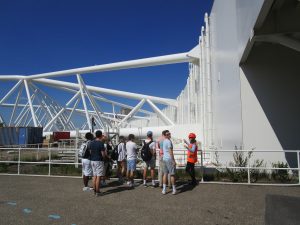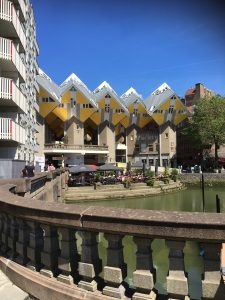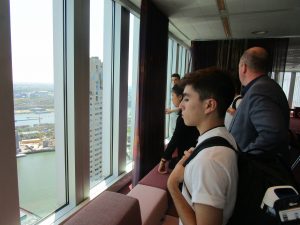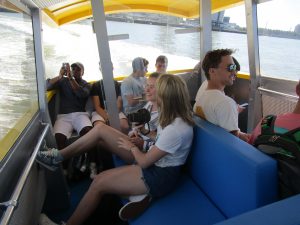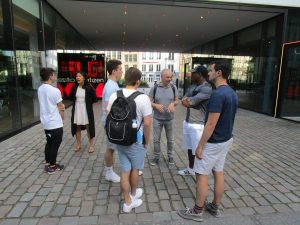Day 3 was a rewarding day filled with talks and travel. In the morning, we all grabbed a final breakfast in the Generator Hostel and headed to the bus. The views of the polder landscape from the bus were picturesque with green fields of horses, small houses, cows and huge greenhouse complexes—though, to be honest, I’m not sure many of us really kept our eyes open for too long. Our power nap prepared us for the day ahead.
After 90 minutes, we arrived at the Maeslantkering, the final piece of the Dutch coastal flood protection system, a storm surge barrier consisting of two enormous robotic arms that swing into place to close off the channel to the Rotterdam harbor to protect the entire region in the event of storm-driven high water. We kick- started our tour with a cup of coffee and some apple tart at Het Kerighuis. On the site tour, we learned about the different dikes that protect the Netherlands. In general, it helped me to really understand the geography of the Netherlands and how interdependant the waterways are. We explored the threats of sea storms, floods and drought with an interactive map. Then it was to time to view the storm surge barrier itself. The sheer size of the machine was incredible. No set of images could prepare me to perceive the enormity and the human ingenuity that went into its construction. The gates are 22 meters high and 210 meters long! In terms of culture what struck me most is the number of back up plans the Dutch had for everything that could go wrong. For example, in the case that the computers shut down there are two sets of back up computers as well as a person there to activate the arms of the Maeslantkering. It was time to head to Rotterdam.
Our rooms were at the StayOkay hostel, a totally flipped out construction–it’s called the Kubusgebouw, built in the 1980s, designed by Piet Blom, who perched canted cubic forms onto concrete pillars in order to approximate the shape of trees in a forest! The building faces on the oldest harbor of the city.
After dropping our bags off, we traveled via water taxi to get to our lecture by Wynand Dassen, project manager of the Rotterdam Resilience Team. The presentation was held on the fortieth floor of the iconic Rotterdam, a world-class building designed by Rem Kohlhaas. The views were stunning! Dassen told us that Rotterdam recently joined the 100 Resilient Cities project. This talk was interesting as it also looked into cultural resiliency. Wyand Dassen explained all the challenges and desires for Rotterdam and how far the city has come since the Germans bombed the city in the Second World War. The culture of sustainability was evident in the reoccurring statement of “collaboration.” It was only our third day in the Netherlands, but it was already clear to us that the Dutch mention consensus and collaboration as important values in every presentation.
This can also be obviously seen in how far Rotterdam has come and how far it proceeds to plan. The city is beautiful and modern and pretty much refuses to be fatalistic about problems. In fact, more than once we heard Dutch experts say that compound problems are their favorite and most productive, because elegant and innovative solutions to multiple problems in one site can win the approval of multiple factions. If the people are not on board, the Dutch organize diverse meetings to talk and listen and act on the perceived issue. This is also practiced in the public conversations held in Rotterdam to ensure that the large migrant population feel they are safe and included.
We took a water taxi across the river to get to our next talk in what used to be an indoor pool and had been converted into a meeting space for sustainability innovators.
Although we were tired, the next conversation with Hans Brouwer, project manager for the Rijkswaterstaat on the ‘Ruimte voor de Rivier’ (Room for the River) project really was interesting. This project was in response to heavy inland flooding from the four major rivers in the mid-1990s. Instead of erecting higher dikes, the Dutch came up with an array of innovative solutions to accommodate increased water volume. The trick to winning the public’s support was, once again, combining problems and benefits, in this case new opportunities to green and improve urban spaces. Mr. Brouwer was the point man for many conversations with individual families and groups in order to win their support and consent for the project. Some fifty private dwellings had to be sacrificed as part of making room for the river. And Mr. Brouwer is exceptionally proud that in every case, a solution was found for the owners that they were satisfied with, that immanent domain was not invoked, and not a single lawsuit was lodged! I love the way Mr. Brouwer explained the approach and how even though many are skeptical about this natural approach to water management, he believes in it and the data already support the success of this innovation. I was drawn to the earthy designs in the room with a lot of potted plants incorporated in the room and what looked like a recycled, triangular wood table.
We quickly checked into the hostel and then walked to the nearby “SocietyM” for our last meeting with Mark Wagenbuur. He is the blogger of the immensely popular “Bicycle Dutch” site. In his day job, Mr. Wagenbuur is a computer programmer, but his lifelong passion has been documenting bicycle culture in the Netherlands. He is a one-man encyclopedia on the history of the urban transformation that followed from the Dutch decision to make the bicycle king of the road. A cardinal rule of Dutch city planning is that there has to be a clear and safe path from any point A to any point B and a place to safely store the bike at both ends. The Dutch building code insists that every home and apartment have sufficient, dedicated interior space for parking bicycles! What I really got from his presentation, however, was not just the importance of cycling. Instead, it was his unabashed passion for all aspects of bicycling that impressed me. It was like a breath of fresh air to speak to someone who was not a professional, per say, in his/her field of work. Cycling was Mark Wagenbuur’s passion. He assured me, and I am sure many others, that even if I do not choose to major in environmental science or urban studies, there is a large network out there where I can do my part.
We ended the day with dinner and a long discussion at StayOkay. It felt great to hang out and talk about all the different things we learned that day and how we feel going forward. A couple of students, myself included, chose to embrace the late evening sunshine and sit out on the docks, chatting about our days with all the roses, few thorns.
Grace
